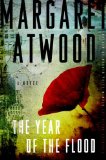Science fiction — excuse me, speculative fiction — loves series. For whatever reason, readers — and evidently authors — can’t get enough of particular worlds or characters. And just as Margaret Atwood distances her fiction from science fiction, she may be taking the concept of a series in a different direction.
 Atwood’s latest novel, The Year of the Flood, is neither a prequel nor a sequel to her novel Oryx and Crake. Yet not only does The Year of the Flood often take place contemporaneously with events in and involve some of the main characters from Oryx and Crake, it approaches its end where the earlier novel itself ended.
Atwood’s latest novel, The Year of the Flood, is neither a prequel nor a sequel to her novel Oryx and Crake. Yet not only does The Year of the Flood often take place contemporaneously with events in and involve some of the main characters from Oryx and Crake, it approaches its end where the earlier novel itself ended.
Both novels deal with an unspecified apocalyptic event (the “Waterless Flood” in the latest) that produced a biological disaster. Most humans have died off as a result of a pandemic plague. The difference here is perspective. Oryx and Crake told of individuals who grew up on the privileged side of a society with an extreme dichotomy between rich and poor. They lived in the compounds of huge multinational corporations that essentially ran the country. The Year of the Flood is told by two former members of a eco/animal rights/vegan/religious organization called God’s Gardeners. Mentioned in Oryx and Crake, the Gardeners live communally in the “pleeblands” and are simply viewed as religious weirdos by most of the regular residents. The two women — Toby and Ren — tell how they survived the apocalypse, not knowing if anyone else did, and detail their individual stories prior to the collapse of society.
To help the reader more easily grasp the ethos and aims of God’s Gardeners, Atwood opens almost all of the book’s 14 sections with a sermon by Adam One, the leader of the group, and every one is preceded by lyrics from a song from the Gardeners “Oral Hymnbook.” excerpt from a hymn sung by the members. (The hymns have now actually been recorded and are being performed during stops on Atwood’s book tour.) The hymns, sermons and “saints” the group celebrates — Rachel Carson, Euell Gibbons, Al Gore, Dian Fossey and E.F. Schumacher among them — provide a device by which to educate the reader on the group while still allowing Ren and Toby to carry the heart of the story.
Ren, who survives because she is in an isolation section of the upscale nightclub/sex club she works in when the plague breaks out, comes to the Gardeners as a child with her mother. Her mother left her husband and the safety of one of the corporate compounds to live with her lover, a Gardener. Ren does return to the compound and her story introduces us to the significant characters from the first novel. Toby, meanwhile, is one of Ren’s teachers with the Gardeners. She takes refuge with the organization to escape a sadist gangster who employed her at SecretBurgers, appropriately named because no one is really quite sure where the protein that goes into the burgers comes from. Her story provides greater backdrop on life in the middle and lower classes before the Waterless Flood. She manages to survive the plague because she left the Gardeners when her refuge there was discovered and began working with a new appearance and a new identity at the AnooYoo Spa. The stories of Ren and Toby largely follow different tracks until near the end, when they leave their hiding places and encounter each other in the post-apocalyptic world.
Ren comes off as more passionate and energetic than others in the story. While Toby is smart and cunning she still seems to have what psychologists would call a flat affect, although perhaps that might be expected from the psychological impact of a highly fatal pandemic. Both are better drawn than most of the other characters. We never really understand what it is about Adam One that makes him the leader of an organization like the Gardeners. Zeb, Ren’s mother’s lover and who eventually heads a splinter group, comes off more like a mysterious swashbuckler. All in all, the people here are not as believable or as convincing as those in her remarkable The Handmaid’s Tale. What is most disappointing, though, is how Atwood brings Ren and Toby — and other characters — together near the end of the book. The coincidences so strain credulity that they border on a deus ex machina.
Atwood deserves praise for the world in which both The Year of the Flood and Oryx and Crake is set. It certainly accords with her view that speculative fiction explores the consequences of technology and what it means to be human, as well as the fact that “we have a better idea about how to make hell on earth than we do about how to make heaven.” But while she has given us plenty to ponder and enough unanswered questions that warrants further exploration of this world, it at times feels as if the Waterless Flood has swept away, or at least severely damaged, the level of pathos and passion of the characters in that world.
What am I living for and what am I dying for are the same question.
Margaret Atwood, The Year of the Flood







